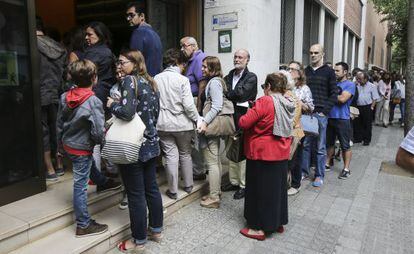Voter turnout at a historic high at Catalan regional elections
Participation rates released at 6pm show Catalans more motivated to vote than ever before


Voter turnout data released at 6pm on Sunday confirmed that Catalonia is living a historic election day.
With two hours to go before polling stations close, over 63 percent of Catalans with the right to vote had already cast their ballots.
Voter participation three years ago had already broken the earlier turnout record
This turnout rate is 6.9 points higher than in the 2012 election, and represents a new historical high for the northeastern region, Catalan government officials confirmed at a press conference.
Voter participation three years ago had already broken the earlier turnout record.
This surge in citizen motivation underscores the importance of a vote that Catalan premier Artur Mas and his secessionist bloc Junts pel Sí (Together for Yes) have cast as a de facto plebiscite on independence.
While Catalans are formally electing their representatives at the regional parliament, Mas has stated that if he wins an absolute majority of seats, he will feel legitimized to push forward with his independence plans for Catalonia.
Although voter turnout has increased across the region, 6pm results show that the spike is somewhat greater in areas that voted for non-secessionist parties in 2012.
These areas, particularly those in Barcelona province, carry greater demographic weight and could thus play a bigger role in the final results.
In Barcelona’s Nou Barris district, for instance, turnout was nearly 59 percent, 5.5 points higher than in 2012. This district’s voters showed the least support for pro-independence parties three years ago.
In the city of Girona, a traditional stronghold of secessionist sentiment, turnout at 6pm had risen four points. In Tarragona, which gave much wider backing to pro-union parties in 2012, turnout was up six points.
In the city of Girona, a traditional stronghold of secessionist sentiment, turnout had risen four points
In such a polarized ballot as this one, preliminary turnout rates are a good indicator of what the final results will look like for each of the two major blocs fighting it out at the polls – those who want unilateral independence and those who want other solutions to the Catalan issue.
Political analysts note that the municipalities, neighborhoods and other administrative divisions that voted massively one way or the other in the past provide a reliable early picture of what Sunday’s final results might look like.
Historically, supporters of independence have been more active voters than other Catalans. This pattern has held true since the first regional elections of 1980. In 2012, however, the gap between both was reduced, and Sunday’s preliminary turnout rates seem to indicate that the difference will be even smaller.
English version by Susana Urra.










































